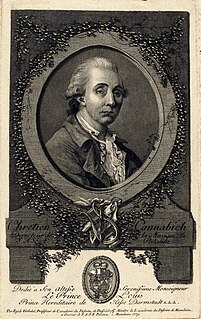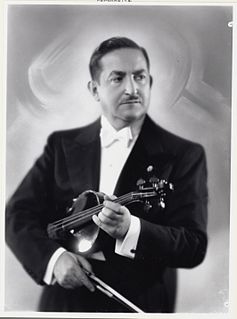 W
WLeopold August Abel was a German violinist and composer. He was born in Köthen in 1718. He was the elder brother of Karl Friedrich Abel, and the grandfather of Johann Leopold Abel. August Abel studied violin under Benda. He played in the orchestra of the theatre at Brunswick, and was successively conductor of the court band to the Prince of Schwarzburg-Sondershausen (1758), the Margrave of Schwedt (1766), and the Duke of Schwerin (1770). He composed a sinfonia a 8 voci in 1766, and some of his violin studies and other compositions are in the possession of the Gesellschaft der Musikfreunde at Vienna. However, he never rose to the reputation of his brother. He died at Ludwigslust on 25 August 1794.
 W
WJohann Ambrosius Bach was a German musician, father to Johann Sebastian Bach.
 W
WRichard Barth was a left-handed German violin virtuoso, conductor, music teacher and composer in the circle of Johannes Brahms. His Ciacona in B minor, Op. 21, composed in 1908, is a finely crafted tribute to J.S. Bach's Chaconne in post-Paganini technical and tonal terms.
 W
WJean Becker was a prominent German violinist from Mannheim in the Grand Duchy of Baden.
 W
WKarl Ferdinand Becker, was a German writer on music, and an organist.
 W
WJohann van Beethoven was a Flemish-German musician, teacher, and singer who sang in the chapel of the Archbishop of Cologne, whose court was at Bonn. He is best known as the father of the celebrated composer Ludwig van Beethoven (1770–1827). Johann was an alcoholic and an abusive father who often beat Ludwig. At 18, Ludwig had to obtain an order to force Johann to support his family. Johann died soon after Ludwig moved to Vienna to study with Joseph Haydn.
 W
WFranz Benda baptised 22 November 1709, Benátky nad Jizerou – 7 March 1786, Potsdam) was a Bohemian violinist and composer, who worked for much of his life at the court of Frederick the Great.
 W
WJosef Benda, also Joseph Benda, was a Bohemian violinist and composer active in Germany.
 W
WKarl Hermann Heinrich Benda, was a German violinist and composer of Bohemian origin.
 W
WJean Joseph Bott was a German violinist and composer who emigrated to the United States late in his life.
 W
WBenedikt Brydern started as a musical protege on the violin giving his first public concerts at the age of 10. He lives in Los Angeles now and composes for film and the concert hall. He has won numerous awards and competitions. He studied with film composers David Raksin, Bruce Broughton, Christopher Young and Elmer Bernstein at the University of California Thornton School of Music in Los Angeles.Immediately after graduation he composed music for Jon Voight's Showtime film The Tin Soldier.
 W
WJohann Christian Innocenz Bonaventura Cannabich, was a German violinist, composer, and Kapellmeister of the Classical era. A composer of some 200 works, he continued the legacy of Johann Stamitz and helped turn the Mannheim orchestra into what Charles Burney described as "the most complete and best disciplined in Europe.". The orchestra was particularly noted for the carefully graduated crescendos and diminuendos characteristic of the Mannheim school. Together with Stamitz and the other composers of the Mannheim court, he helped develop the orchestral texture that paved the way for the orchestral treatment of the First Viennese School.
 W
WJi-In Cho is a German heavy metal singer of Korean descent. She has been the lead vocalist and pianist of the symphonic metal band Krypteria since December 2004 until their hiatus after her pregnancy. Following this, she became the lead vocalist of And Then She Came, a band consisting of most of the former members of Krypteria.
 W
WFranz Carl Adalbert Eberwein was a German composer and violinist. He was born in Weimar, Germany and learned music under the consultation of his father. He was good friends with Johann Wolfgang von Goethe, and put music to many of his works, such as Faust and to Proserpina. There is also at least one flute concerto, a quatuor brillant in A major, song cycles and cantatas
 W
WRenate Eggebrecht is a German violinist and record producer.
 W
WHeinrich Joseph Esser was a German violinist, influential conductor and composer.
 W
WBernard Etté was a German jazz and light music violinist and conductor.
 W
WJohann Fischer (1646–1716) was a German violinist, keyboardist and composer of the baroque era. His name is not to be confused with another composer named Johann Fischer, born in Lübeck and listed by Johannes Moller in Cimbria literata. He is mentioned as a good clavier and violin player, who is said to have especially loved the return of the strings and, in this way, he mainly composed for the violin and also the viola, which he sought to write for in his overtures. In any case, his works are of historical interest since they are likely to betray the influence of the then French instrumental music.
 W
WFerdinand Fränzl was a German violinist, composer, conductor, opera director, and a representative of the third generation of the so-called Mannheim school.
 W
WIgnaz Fränzl was a German violinist, composer and representative of the second generation of the so-called Mannheim School. Mozart who heard him at a concert in November 1777 wrote of him in a letter to his father: He may not be a sorcerer, but he is a very solid violinist indeed. Fränzl carried the Mannheim violin technique, established by Johann Stamitz, one step further to real virtuosity. Mozart, quite a good violinist himself and thoroughly acquainted with the instrument, praised Fränzl's double trill and said he had never heard a better one.
 W
WRudolf Gaehler is a German violinist. He uses the curved bow for playing polyphonic music.
 W
WAugustin Hadelich is an Italian-German-American Grammy-winning classical violinist.
 W
WPhilip Adolph Herfort was a German violinist, violist and orchestra leader.
 W
WGustav Hollaender was a German violinist, conductor and composer. He composed many violin works including violin concerti. He was uncle of the more famous film composer Friedrich Hollaender.(See Great Jews in Music by Darryl Lyman).
 W
WGeorge H. Hucke was a musician, playing both violin and mandolin, and he became one of the most popular English composers for the mandolin. He was also the author of an 1893 mandolin method called Forty Progressive Studies for the Mandoline, published by John Alvey Turner. Part of the BMG movement.
 W
WPaul Klengel was a German violinist, violist, pianist, conductor, composer, editor and arranger. He was the brother of cellist Julius Klengel.
 W
WAnna Katharina Kränzlein, also known as Anna Katharina, is a German violinist. She is most known for her quick and varied technique. She is the youngest founding member of Medieval folk rock/folk metal band Schandmaul.
 W
WLudwig Wilhelm Maurer was a German composer, conductor, and violinist born in Potsdam. In 1802, he debuted in Berlin with his first major violin performance. After a brief period of studying French violin style in Mitau (Latvia), Maurer went to Russia at age 17 in 1806, where he would stay for most of his life. For this reason, Maurer is considered both a German and a Russian composer.
 W
WBernhard Molique was a German violinist and composer.
 W
WJohann Georg Leopold Mozart was a German composer, conductor, music teacher, and violinist. Mozart is best known today as the father and teacher of Wolfgang Amadeus Mozart, and for his violin textbook Versuch einer gründlichen Violinschule.
 W
WHermann Necke was a German composer, conductor, music director, pianist, and violinist of the Romantic period. He is best known for the galop Csikós Post, first published in 1895 as part of Klänge aus Ungarn [Sounds from Hungary], Opus 286.
 W
WJohann Georg Pisendel was a German Baroque musician, violinist and composer who, for many years, led the Court Orchestra in Dresden, then the finest instrumental ensemble in Europe.
 W
WFriedrich Wilhelm Pixis was a German violinist. He became professor of violin at Prague Conservatory and was important in the musical life of Prague.
 W
WHerbert "Herb" Rehbein was a German songwriter, composer and arranger of light orchestral music. Together with his friend and collaborator Bert Kaempfert, he was posthumously inducted into the Songwriters Hall of Fame in 1993.
 W
WFranz Anton Xaverius Ries was a German violinist. His father Johann Ries (1723–1784) was court trumpeter to the Elector of Cologne in Bonn. Ries was born in Bonn, and studied under J.P. Salomon. He was a child prodigy, and was concertmaster of the Kurfürstlichen Hoforchester in Vienna. He spent most of his life in Bonn, though he had success in his early years in Vienna as both a solo violinist and in quartets. One of his students in Bonn was the young Beethoven. He was given an appointment by Elector Maximilian in 1779, which he kept until the court's dissolution in 1794. After this he continued teaching; he was awarded an Order of the Red Eagle and an honorary doctorate from Bonn University. He died in Godesberg.
 W
WAlexander Sascha Ritter was a German composer and violinist. He wrote two operas - Der faule Hans and Wem die Krone?, a few songs, a symphonic waltz and two symphonic fantasias. Ritter died in Munich.
 W
WAndreas Jakob Romberg was a German violinist and composer.
 W
WEngelbert Röntgen was a German violinist, for many years concertmaster of the Leipzig Gewandhaus Orchestra.
 W
WJohann Peter Salomon was a German violinist, composer, conductor and musical impresario. Although he was an accomplished violinist, he is best known for bringing Joseph Haydn to London and for conducting the symphonies that Haydn wrote during his stay in England.
 W
WThomas Täglichsbeck was a German violinist and composer.
 W
WCarl Herrmann Unthan was a Prussian-born violinist and actor who was born without arms.
 W
WFrancesco Venturini was a musician and Baroque composer of unclear origin, despite his Italian-sounding name. In 1698 he became violinist in the court chapel of Electorate of Hanover, where he had married in the previous year. There is some evidence suggesting that he originated from present-day Belgium because his sons are recorded in the baptismal register as "Bruxellensis". In 1714, Venturini was named Kapellmeister, head of the court orchestra, and held this post until his death. He was a renowned composer in his time. He created chamber music, concerts and other works essentially in the suite form. His Concertos Op. 1 were printed 1715 by Estienne Roger in Amsterdam.
 W
WMarek Weber was a German violinist and bandleader.